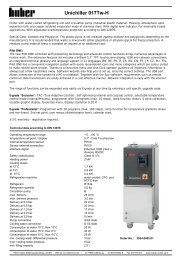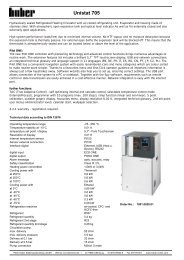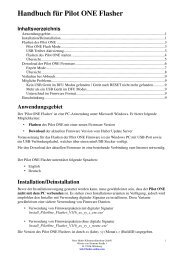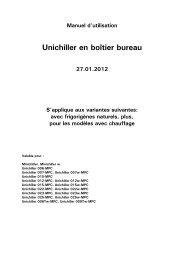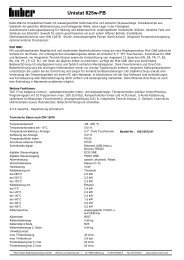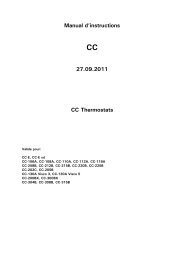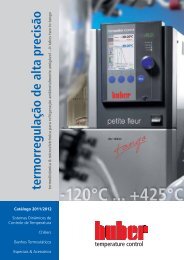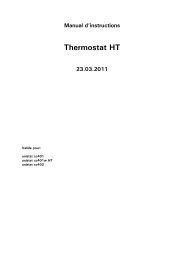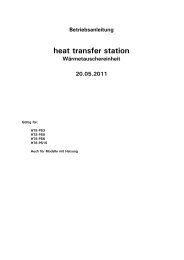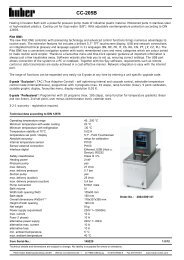Operating manual 27.09.2011 CC Heating Thermostats - HUBER
Operating manual 27.09.2011 CC Heating Thermostats - HUBER
Operating manual 27.09.2011 CC Heating Thermostats - HUBER
You also want an ePaper? Increase the reach of your titles
YUMPU automatically turns print PDFs into web optimized ePapers that Google loves.
After selecting the main menu point Control parameters, the following functions are<br />
available:<br />
28<br />
� Select autom./<strong>manual</strong><br />
� Config. automatic<br />
� Config. <strong>manual</strong> parameters<br />
� Reset control parameters<br />
� Display parameters<br />
� Go back<br />
Select Autom. / Manual (Select Automatic / Manual)<br />
Application of the automatically detected or <strong>manual</strong>ly entered parameters, in order to<br />
regulate the temperature. We recommend the setting: Automatic control parameters!<br />
Config. Automatic (Automatic configuration)<br />
The following functions are available:<br />
� Find control parameters<br />
� Control dynamics<br />
� Display control parameters<br />
� Fluid properties<br />
� Go back<br />
Find control parameters<br />
Several options of controller parameterisation are available:<br />
1. Fast identification (valid as from E-Grade Exclusive)<br />
2. With preliminary Test (valid as from E-Grade Exclusive)<br />
3. Estimate control parameters (valid as from E-Grade Basic)<br />
1. Fast identification:<br />
Delivers a relatively fast and reliable control parameter with which a rapid regulation<br />
with a relatively high constancy can be reached.<br />
First, start temperature control and run for some minutes to achieve a suitable stable<br />
set-point. During the following do not carry out any changes on the system (e.g. filling /<br />
emptying the reactor core, change of agitator speed, change of the process sensor<br />
position etc.).<br />
After activating this function, a table with thermal fluids is displayed. Select the<br />
appropriate thermal fluid here. If your thermal fluid is not listed in the table, please<br />
select no specification. If your thermal fluid is not listed, the controller assumes a<br />
thermal fluid with characteristics, which normally results in an overshoot-free (slower)<br />
control. After selecting the thermal fluid, you are asked, whether you want to identify<br />
and control Internal or Process (cascade or set-point tracking). You are then requested<br />
to enter a set-point. Please note, that the identification is only successful, if the new<br />
set-point differs from the current set-point by at least 10 K. In the status field of the<br />
chart display (60), the information Temp. + Ident. active is displayed.



